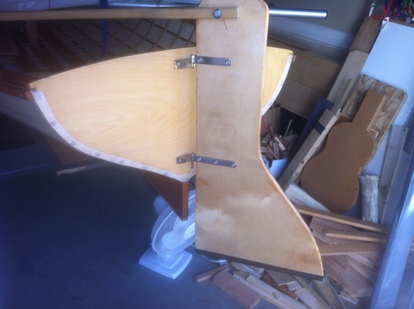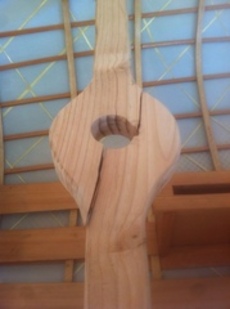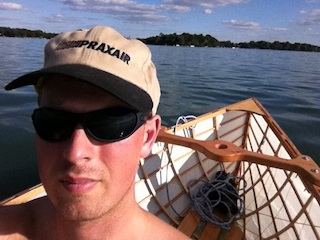Rudderectomy
There's no better way to start the new sailing season than to design away the problems of the last one. The original rudder design of the Classic 12 had a slight technical problem in that the buoyancy of the rudder would float the pins right out of their sockets. Not so useful. A bungee cord could work around that, but trying to get two pins lined up and held from floating off while trying to attach a bungee with one hand in waves is easier said than done. We'll have none of that in 2012.

My first inclination was to screw some flat bar on both sides of the rudder above the waterline to weight it down. Ugly, and boring. Pass. In addition to the buoyancy problem, the original protrudes well below the skeg, risky in the case of accidental grounding and also probably creating unneccessary drag.
After a winter of perusing Boats With an Open Mind, I wanted to try using a Bolger rudder plate and reducing the draft and area of the rudder. Making the plate out of flat bar kills two birds with one stone: counteract buoyancy with weight and make the rudder more effective with a smaller area. At least in theory...

I marked a spot just below the end of the skeg and marked a line to get a good flat edge to mount the end plate.

I have a very vivid memory of my grandfather asking me to cut a metal bench base with a hacksaw and then giving me a disgusted "kids these days" when I started acting tired after a few minutes of hacksaw time. This project seemed like a perfect opportunity to continue the family tradition of scarring youngsters with unattainable expectations. Just kidding. The Boy made a valiant effort at the flat bar and I didn't even tease him (which took some willpower). But I digress...

My end plate is fairly skinny compared to pictures of Bolger's endplates I've seen because of the weight of the flat bar (and because that's the width that Home Depot had in stock). The great thing about small boat experiments is if it fails you're only out about 10 bucks. Plus, they're fun.

The finished product came out OK, although the plate alignment isn't quite perfect. Rudder trial day turned out to be a blustery 60 degree, 15-20 knot day. Not bad for April in Minnesota. The rudder acquitted itself quite well. It steered well, and we went fast enough to notice some cavitation. This might be due to the slight crookedness of the plate, or I might need to fair the trailing edge. Not bad for a first effort.
Unfortunately, to prove that projects beget projects, the high winds proved a bit too much for the mast step. Check one off my bucket list of boat dramas. Capsize? Check. Dismasted? Check!

Good thing I had a newbie crew with a good sense of humor and willingness to spell me at the oars. All the way back up the lake. Against the wind and whitecaps. A fine adventure was had by all. We'll see if he comes back out.
And now a new mast step goes to the top of the projects queue. My Storer cassette rudder and daggerboard will have to wait. C'est la vie.
blog comments powered by Disqus
About Me
Subscribe
to this weblog'sRecent Articles
Best Books of 2013How to Create a Histogram with SQL
Bulletproof Coffee Redux
On Being T-Shaped
Rudderectomy